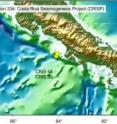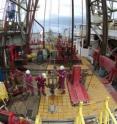Scientists study earthquake triggers in Pacific Ocean
Related images
(click to enlarge)
New samples of rock and sediment from the depths of the eastern Pacific Ocean may help explain the cause of large, destructive earthquakes similar to the Tohoku Earthquake that struck Japan in mid-March. Nearly 1500 meters (almost one mile) of core collected from the ocean floor near the coast of Costa Rica reveal detailed records of approximately 2 million years of tectonic activity along a seismic plate boundary.
The samples were retrieved with the scientific drilling vessel JOIDES Resolution during the recent month-long Integrated Ocean Drilling Program (IODP) Costa Rica Seismogenesis Project (CRISP) Expedition. Participating scientists aim to use the samples better understand the processes that control the triggering of large earthquakes at subduction zones, where one plate slides beneath another.
"We know that there are different factors that contribute to seismic activity – these include rock type and composition, temperature differences, and how water moves within the Earth's crust," explained co-chief scientist Paola Vannucchi (University of Florence, Italy), who led the expedition with co-chief scientist Kohtaro Ujiie (University of Tsukuba, Japan).
She added, "but what we don't fully understand is how these factors interact with one another and if one may be more important than another in leading up to different magnitudes of earthquakes. This expedition provided us with crucial samples for answering some of these fundamental questions."
More than 80% of global earthquakes above magnitude 8.0 occur along subduction zones. The Pacific Ocean is famous for these boundaries, known as convergent margins, which are found along the coasts of the East Pacific from Alaska to Patagonia, New Zealand, Tonga, Marianas all the way up to Japan and the Aleutians, making the margins of the world's largest ocean basin a primary target for research into the triggering mechanisms of large quakes.
During four weeks at sea, the science party and crew successfully drilled four sites, recovering core samples of sand and clay-like sediment and basalt rock. In a preliminary report published this month, CRISP scientists say that they have found evidence for a strong subsidence, or sinking, of the Costa Rica margin combined with a large volume of sediment discharged from the continent and accumulated in the last 2 million years.
"The sediment samples provide novel information on different parameters which may regulate the mechanical state of the plate interface at depth," said Ujiie. He adds, "knowing how the plates interact at the fault marking their boundary is critical to interpreting the behavior and frequency of earthquakes in the region."
Vannucchi explains, "for example we now know that fluids from deeper parts of the subduction zone system have percolated up through the layers of sediment. Studying the composition and volume of these fluids, as well as how they have moved through the sediment helps us better understand the relationship between the chemical, thermal, and mass transfer activity in the seafloor and the earthquake-generating, or seismogenic, region of the plate boundary. They may be correlated."
Cores from the CRISP Expedition are currently being further analyzed by different members of the research party at their home institutions. The scientists will meet beginning August 29 at Texas A&M University to share their initial results.
The CRISP Expedition is unique because it focuses on the properties of erosional convergent margins, where the overriding plate gets "consumed" by subduction processes. These plate boundaries are characterized by trenches with thin sediment cover (less than 400 meters), fast convergence between the plates (at rates greater than 8 centimeters per year), and abundant seismicity.
The seismically active CRISP research area is the only one of its kind that is accessible to research drilling. However, this subduction zone is representative of 50% of global subduction zones, making scientific insights gleaned here relevant to Costa Ricans and others living in earthquake-prone regions all around the Pacific Ocean. The recent Tohoku Earthquake in Japan was generated in an erosive portion of the plate interface.
Other geoscience research drilling programs, such as IODP's Nankai Trough Seismogenic Zone Experiment (NantroSEIZE), near the southeast coast of Japan, focus on accretionary margins, where the front part of the overriding tectonic plate is built up by the subduction processes (sometimes forming mountains) and the plate boundary input is trench material. In these environments, the trench sediments are significantly thick (greater than 1000 meters or over a half a mile). Accretionary margins are known for their large earthquakes as the 1964 Alaska and the 2004 Sumatra quakes. Japan's Nankai Trough itself was the center of two magnitude 8 earthquakes in 1944 and 1946.
The CRISP team hopes to return to the same drill site in the future to directly sample the plate boundary and fault zone before and after seismic activity in the region. Changes observed through this work may provide new insights into how earthquakes are generated.


